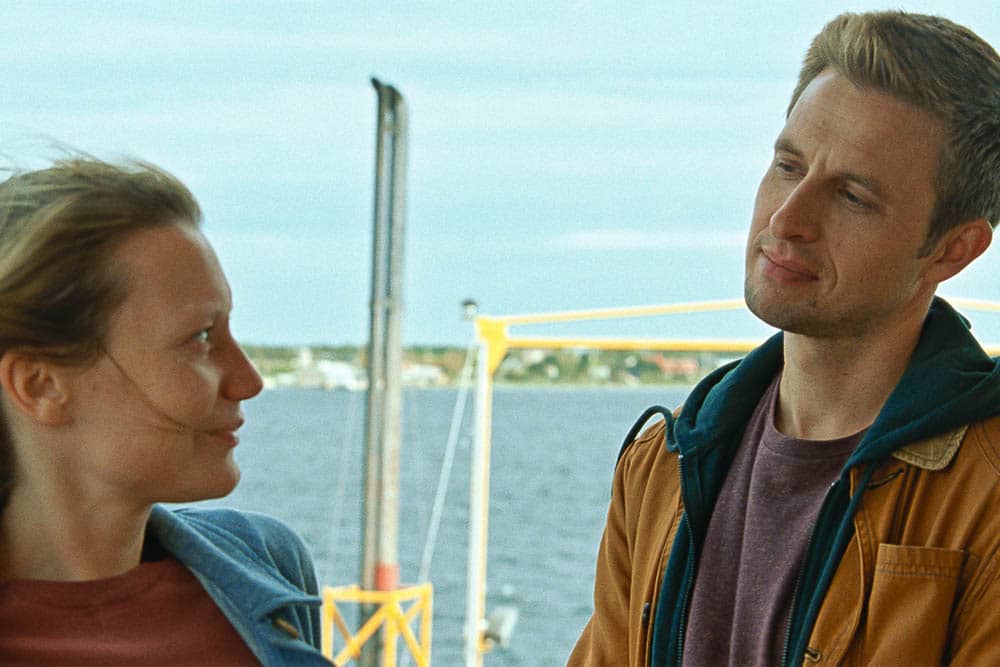
Bergman Island (2021) is a gentle drama, a quiet whisper among more provocative films. If it were not for the name of the famous Swedish filmmaker Ingmar Bergman in its title, Mia Hansen-Løve’s intimate exploration of anxiety in love and the creative process, might struggle to draw an audience’s attention.
Filmmaking couple Chris (Vicky Krieps) and Tony (Tim Roth), take a summer retreat to the island of Fårö, the home of Bergman, where he shot many of his films. Both are in search of inspiration for their new projects, and with Tony’s latest film screening on the island, he’s invited to panel and post-screening discussions. While her husband enjoys the warm reception of his film and effortlessly writes, Chris’ creative struggles lead her to find inspiration in the story of her first love, which blurs the line between fiction and reality.
Bergman’s presence is felt from the moment the couple arrives, suggesting artists are ghosts that remain with us long after their deaths. We speak of deceased artists in the past tense, but their discovery by a new generation, the ongoing discussion of their work, and their inspirational influence allow them to endure.
Indeed, works of art create haunting memories of encounters with someone we may have never met, yet who touched us in some way. They’re a voice from beyond the grave, and as Chris says about her protagonist, Amy (Mia Wasikowska), “Bergman occupies a very important place in her imagination. For many, he’s a formidable reference, but for her, he’s a sort of refuge, a consolation…”
This choice of words is interesting because the way she relates to Bergman’s art is a conflict between affection and despair. Back in their room after watching Cries and Whispers (Bergman, 1972) in Bergman’s private screening room, Chris rhetorically asks Tony, “Why didn’t he want to explore happiness?” She says, “… Look at this place. His houses, the island, the beautiful landscapes. Everything is less harsh than in his movies.”
Bergman understood that happiness is self-indulgent; the opportunity for personal growth lies in exploring the harsher spectrum of human emotions. It’s here that catharsis or enlightenment is discovered in the existential abyss – if we’re willing to look into it. Chris denies this catharsis in the Swedish auteur’s work, when she declares, “Movies can be terribly sad, tough, violent, but in the end, they do you good.” Bergman’s films, she says, hurt her. When Chris asks why she watches them, she ambivalently answers, “Because I love them. I just don’t know why that’s all.”
This scene sets up an ironic twist and the broader point about the submissive artist. Chris shares the outline of her new project with her husband. It’s a story about two former lovers, Amy and Joseph (Anders Danielsen Lie), who reunite at their friend’s wedding on Fårö. She describes it as, “…the last chapter of their story, which was just a series of failures and betrayals and dramas. The story of impossible mourning of suffering overshadowed by a few memories of intense happiness.” Earlier, she too rebukes Bergman for his failure to explore happiness in his films, using the beautiful surroundings as a stage for a harsher tale, and she contradicts herself by exploring her own painful torment with love.
It’s true that Bergman’s films don’t reassure his audience, instead, they motivate viewers to think more deeply, and enrich their perspective on human nature. Chris and Bergman represent the submissive artist who has little control over the stories they tell. They’re forced to follow their inspiration that doesn’t often explore happiness, but instead, focus on the anxiety or agony of life.
Chris and Bergman treat their work as art therapy, a cathartic experience intended for them, not their audience. That Chris cannot understand this is confounding, but that’s Hansen-Løve’s intent: to show that we are blinded by our feelings, and that misleads our ideas about art and life.
Creativity and love are inseparable as the director shows how easy love and the creative process can be, but they can also be slow and difficult. Bergman Island asks deeper and unoriginal questions about love, such as, whether we can love more than one person in our lifetime.
This tantalising idea is provoked by Amy and Joseph’s conversation about betrayal. Are you unfaithful to your partner or spouse if you’re in love with the other person? Is betrayal an act of lust, not love? The traditional emotional contracts that form the basis of our relationships should render this conversation void, but it’s an intriguing thought to consider.
In their post-coital conversation, Joseph tells Amy that his girlfriend is jealous of her, but reminds Amy that she is unfaithful too. Is Amy as much a victim of betrayal as Joseph’s girlfriend is? If we do right by others, in circumstances that require us to deny our feelings, do we not make ourselves a victim of betrayal? To understand Bergman Island the audience must consider such questions.
An illuminating, compatible book that addresses the extremes of the conversation that Hansen-Løve’s film raise is Sex at Dawn: How We Mate, Why We Stray, and What It Means for Modern Relationships (2014), by the research psychologist Christopher Ryan and psychiatrist Cacilda Jetha. Bergman Island is a gentle story about creativity and love, and it explores these themes with a surprisingly inquisitive soul.


![Call for Papers: All Things Reconsidered [MUSIC] May-August 2024](https://www.popmatters.com/wp-content/uploads/2024/04/all-things-reconsidered-call-music-may-2024-720x380.jpg)



